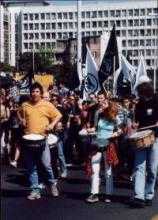Within two years of its founding in 1998, the Serbian youth group Otpor (Resist) played a central role in bringing down Slobodan Milošević. Initially their campaign aimed to change attitudes towards resisting Milošević, for instance by using nonviolent 'guerilla' tactics of communication (graffiti, street theatre, etc.), often using humour to attract interest and to reduce fear. Increasingly, they put pressure on the divided democratic opposition and found points of unity to counter Milošević and to undermine 'the pillars of his power'.
Nonviolence training workshops played an important role in spreading an understanding of how they could weaken the regime. When Milošević did try to steal the elections, they were in a position to expose him and ultimately to stop him. When crowds surrounded the parliament building, the police were unwilling to disperse them. The most famous image is of a bulldozer driving into the parliament; by that time, the police made no effort to prevent this. The next day Milošević resigned.
Otpor had played a vital role in achieving a necessary step in democratising Serbia—removing Milošević—but subsequent progress towards democracy has been disappointing.
Resources:
- 'Bringing Down a Dictator', DVD, 60 minutes, a production of York Zimmerman Inc., Washington, D.C., USA
- Albert Cevallos,'Whither the Bulldozer?: Nonviolent Revolution and the Transition to Democracy in Serbia' (US Institute of Peace special report No 72 - downloadable from http://www.usip.org)
- The Website for the Centre for Applied NonViolent Action. Strategies includes articles by Otpor activists and others on their strategy and tactics: http://www.canvasopedia.org/content/serbian_case/otpor_strategy.htm

Comments
There are no comments on this article. Have you got something related to this topic, you'd like to say? Please feel free to be the first person to make a comment.
Add new comment